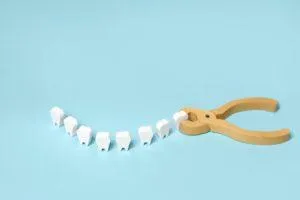Read All About It
Dental Related Articles


Baby Tooth Extraction: What Parents Should Know
Hearing that your child may need a baby tooth extraction can be alarming news. Your child may become scared or anxious and you may be worried about it as well. It should be a comfort to learn that baby tooth extraction procedures are very common for children.

Why extract baby teeth?
Baby teeth don’t always need to be extracted; in many cases, they just need to be filled. Extracting children’s teeth is usually a last resort, but in some situations, it is necessary.
Your child’s pediatric dentist may recommend removing a tooth if:
A baby tooth is blocking the growth of an adult tooth
If a baby tooth stays in place too long, it can block the eruption of the permanent tooth underneath. This can cause crowding, overlapping teeth, or misalignment as your child’s adult teeth begin to grow in. Removing the stubborn baby tooth early gives the adult tooth space to come in straight and healthy — often preventing the need for orthodontic treatment later.
Severe decay or infection is present
In some cases, a cavity or infection in a baby tooth can be too advanced for a filling or crown. Leaving the tooth untreated can cause pain, swelling, or even infection in nearby teeth and gums. Extracting the affected tooth stops the spread of bacteria and protects the developing permanent tooth beneath it.
The tooth is damaged beyond repair
Children are active — bumps and falls happen! If a tooth is cracked or broken to the point that it can’t be restored, an extraction might be the safest solution.
Removing the damaged tooth helps prevent infection and keeps your child’s bite aligned as new teeth come in.
Space is needed to prevent crowding or misalignment
Sometimes, a baby tooth needs to be removed to make room for other teeth or to prepare for orthodontic treatment.
In these cases, your pediatric dentist may use a space maintainer — a small, custom dental device that keeps the gap open until the permanent tooth is ready to erupt. This helps prevent future crowding or shifting.
Removing a baby tooth early can help guide healthy permanent tooth development and protect your child’s long-term smile.
Before Extraction
Be transparent
Before your child gets their baby tooth extracted, it would be wise to explain what will happen in a calming manner. You can do this by asking your pediatric dentist to provide information on the procedure or by searching the internet for more in-depth information. Familiarizing your child with the procedure will help them grasp the concept and hopefully alleviate some of their worries.
Stay positive
One of the most important things in preparing your child for a baby tooth extraction procedure is to remain positive. It’s incredible how much children rely on their parents to gauge how they should react to situations. If you’re panicking and airing your fears or frustrations with the procedure, your child will soak that right up and begin to internalize those fears.
The last thing you want is for your child to have uncontrollable anxiety over a procedure, so it’s better to stay positive and remind your child of all the good that will come from it.
Peer experience
Having information from the dentist and websites may be helpful, but you still may feel unprepared or ill-informed. If possible, you could ask some other parents you know, or simply post about your concerns on social media. If one of your child’s friends has gone through it, try asking their parents.
Others who have children that have gone through the same procedure can tell you how it went for them and let you know the basics of what to expect and how to handle aftercare. Including your child in these conversations may help them overcome some of their fears once they hear that people they know have gone through the same thing.
Provide comfort
Even if you’ve explained baby tooth extraction to your child and they’ve heard from other parents and kids about the procedure, they still may be anxious about it. You can comfort your child and give them an incentive to go through with it by mentioning that the tooth fairy will pay them extra for this tooth, or reminding them that they’ll get to eat a lot of ice cream the days after the procedure.
On the day of the tooth extraction, allow your child to bring their favorite toy. Having something familiar will hopefully soothe some of their anxieties and bring them some comfort.

Extraction
Your child’s dentist will likely walk you and your child through the procedure when the time comes. The basic steps are as follows:
Step 1 – X-ray
Before the procedure begins, most dentists will want to take x-rays of your child’s teeth, which will show the dentist or oral surgeon the bone structure and the tooth’s roots. This helps them get a full visual look at the tooth that needs to be extracted and it allows them to see where complications may occur.
Step 2 – Local anesthesia
The next step would be to administer local anesthesia to the extraction area. Local anesthesia will numb the area and allow the dentist or oral surgeon to work on your child’s teeth without causing pain. This is standard for a tooth extraction. However, if your child is dealing with extreme dental anxiety, sedation may be necessary.
Step 3 – Tooth extraction
After anesthesia has been given, the dentist or oral surgeon will extract the tooth carefully while also making sure the bone surrounding the tooth remains undamaged.
Step 4 – Stitches
When the extraction is completed, the dentist will cover the empty tooth socket with gauze and pressure will need to be applied for about twenty minutes. Not everyone needs stitches after a tooth extraction, but some do. It depends on the child’s individual needs.
Step 5 – Space maintainer
Space maintainers are dental devices used to keep space between teeth to allow a permanent one to grow in. They are used most often with the extraction of molars. Though if your dentist sees that there is enough space between your child’s teeth for a permanent tooth to grow in, a space maintainer may not be needed.
After Extraction
It’s important to follow the aftercare directions your pediatric dentist will provide to you to avoid complications.
Aftercare guidelines following tooth extraction:
1. Keep Pressure on the Gauze
Once the extraction is complete, your child will bite down gently on a piece of sterile gauze for about 20–30 minutes. This helps form a healthy blood clot and minimizes bleeding.
If bleeding continues, replace the gauze with a fresh, damp piece and have your child keep light pressure until it stops.
2. Keep Your Child’s Head Elevated
For the first few hours, have your child rest with their head slightly elevated on a pillow. This improves blood circulation and helps reduce swelling. Try to avoid letting your child lie flat or run around right after the procedure.
3. Keep the Mouth Clean
Good oral hygiene is important even after a tooth extraction. Encourage your child to brush gently around the extraction site while keeping the area clean and free of food particles.
Avoid rinsing or spitting forcefully for the first 24 hours—this can dislodge the blood clot that protects the healing socket.
4. Hands Off the Area
Remind your child not to touch the extraction site with their fingers or tongue. This helps prevent infection and irritation. If your child is young, you may need to keep an eye on them or offer gentle reminders.
5. Use Ice Packs for Swelling
Mild swelling is normal after a tooth extraction. Use a small ice pack or cold compress on the outside of the cheek for 10–15 minutes at a time.
Take short breaks between applications to avoid skin irritation. The swelling should go down within 24–48 hours.
6. Follow Medication Instructions
If your pediatric dentist prescribes medication, give it exactly as directed. This may include antibiotics to prevent infection or mild pain relief to keep your child comfortable.
Over-the-counter children’s pain relievers may also help, but always check with your dentist before giving any medication.
7. Offer Soft, Easy-to-Eat Foods
For the first day or two, stick to soft foods that are gentle on the mouth—like yogurt, mashed potatoes, applesauce, smoothies, or soup (not too hot).
Avoid crunchy or sticky foods that could irritate the area, such as chips, candy, or chewy snacks.
8. Keep Your Child Hydrated
Encourage your child to drink plenty of water to stay hydrated. Avoid using straws, since the suction can dislodge the blood clot and slow healing.
Cool water is best—skip carbonated drinks, citrus juices, or anything too cold or too hot.
9. Maintain a Calm Environment
After a dental procedure, it’s normal for children to feel tired. Let your child relax at home with a favorite movie or book. Keeping activity levels low helps prevent bleeding and promotes faster healing.
10. Monitor for Any Unusual Symptoms
Watch for signs of complications such as excessive bleeding, severe pain, fever, or swelling that worsens after 48 hours. If anything seems out of the ordinary, contact Hurst Pediatric Dentistry right away.
Our team is always available to answer questions and make sure your little one heals comfortably and safely.
If your child experiences any itching or abnormal swelling after taking medications, contact your child’s dentist or go to your nearest emergency room. You should also discourage your child from swishing liquids in their mouth or sucking from straws, as this could dislodge the healthy blood clot in the empty socket.
Baby tooth extractions should heal relatively quickly within one or two days. However, permanent tooth extractions should heal within a few days. The healing may take longer depending on if your child has certain medical conditions.

Possible Complications
Numbness
After the procedure, your child will likely remain numb for a while, though the anesthesia should wear off after one to six hours.
Bleeding
It’s normal to experience bleeding after tooth extraction. If the bleeding becomes too much, use a dampened gauze pad and have your child bite down on it for thirty minutes. Excessive bleeding is caused by increased blood flow, so make sure your child refrains from running around until their blood can clot and form a scab over the empty socket.
Swelling
Swelling from the procedure should go down after a few days to about a week. Immediately following a tooth extraction, ice packs can be applied to the affected area, though make sure to do this in short intervals to avoid irritation.
Soreness
Sometimes, a patient may experience soreness in the jaw and/or have difficulty chewing or swallowing a few days after the procedure. They may also have a hard time trying to open and close their mouth. This should go away on its own over time.
Dry socket
Although very rare in children, dry socket is a complication to be aware of. Dry socket occurs when the blood clot formed in the empty socket becomes irritated and dislodges before it should. This is accompanied by a throbbing pain that reaches up to the ear. If your child experiences this, it can be treated back at the dentist’s office.
Dead bone or tooth fragments
Also rare, there are instances where fragments of tooth or bone were unable to be extracted during the procedure. If this happens, your child’s dentist will inform you. But don’t worry, these fragments will remove themselves by working their way through the gums over the healing period. This process may cause a bit of pain.
Infection
Rarely, the site of the extraction could become infected. Symptoms of this are pain spreading along the face, ears, and neck, facial redness or swelling near where the tooth was removed, and bad breath or taste in the mouth. If your child starts to experience this, contact the dentist.
Nerve damage
Nerve damage after extractions from the lower jaw is also rare, and will most often be temporary as your child’s mouth heals. Symptoms of nerve damage are numbness around the extraction area or numb lips. Contact the dentist if your child mentions this.
Bottom Line
A baby tooth extraction may sound intimidating, but with the right care, it’s a simple and safe procedure that helps protect your child’s long-term smile. By following your pediatric dentist’s aftercare instructions, keeping your child comfortable, and maintaining a calm, positive attitude, you’ll set the stage for quick healing and healthy permanent teeth.
At Hurst Pediatric Dentistry, we’re here to make every step easy, gentle, and stress-free — because every child deserves a healthy, happy smile from the very start.
To learn more about baby tooth extraction, the procedure itself, or possible complications, contact us or call (205) 969-7454.

19 INVERNESS CENTER PARKWAY, STE 250, BIRMINGHAM, AL 35242
TEL: 205.969.7454
E-MAIL: [email protected]
2018 © ALL RIGHTS RESERVED | PRIVACY POLICY | TERMS AND CONDITIONS
Site by Trustway Marketing Powered by Kyrios Systems